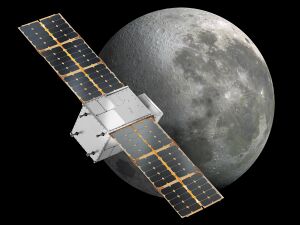Engineering:CAPSTONE (spacecraft)
 Illustration of the Cislunar Autonomous Positioning System Technology Operations and Navigation Experiment (CAPSTONE). | |
| Names | Cislunar Autonomous Positioning System Technology Operations and Navigation Experiment |
|---|---|
| Mission type | Technology demonstration |
| Operator | NASA |
| Mission duration | 9 months (planned) |
| Spacecraft properties | |
| Spacecraft | CAPSTONE |
| Spacecraft type | 12U CubeSat |
| Bus | CubeSat |
| Manufacturer | Advanced Space (management) and Tyvak Nano-Satellite Systems (bus) |
| Launch mass | 25 kg (55 lb) [1] |
| Start of mission | |
| Launch date | 19 March 2022 (planned) [2] |
| Rocket | Electron |
| Launch site | Mahia, LC-1A[3] |
| Contractor | Rocket Lab |
| Moon orbiter | |
| Orbits | Near-rectilinear halo orbit (NRHO)[1] |
Cislunar Autonomous Positioning System Technology Operations and Navigation Experiment (CAPSTONE) is a lunar orbiter that will test and verify the calculated orbital stability planned for the Gateway space station. The spacecraft is a 12-unit CubeSat that will also test a navigation system that will measure its position relative to NASA's Lunar Reconnaissance Orbiter (LRO) without relying on ground stations.
Overview
The Gateway is an in-development space station being planned by several national space agencies since at least 2018, including NASA, European Space Agency (ESA) and Canadian Space Agency (CSA). The Gateway is planned to be placed in lunar orbit and intended to serve as a solar-powered communications hub, science laboratory, short-term habitation module, and holding area for rovers and other robots.[4] It would play a major role in NASA's Artemis program.
Computer simulations indicate that this particular orbit — a near-rectilinear halo orbit (NRHO) — offers long-term stability with low propellant requirements for orbital station-keeping,[5] by using a precise balance point in the gravities of Earth and the Moon that offers a stable trajectory.[6]
The main objective of the CAPSTONE mission is to verify the calculated orbital stability simulations for the Gateway.[7][6][8] CAPSTONE will be the first spacecraft to operate in that unique lunar orbit.[8][6] The spacecraft will also test a navigation system called Cislunar Autonomous Positioning System (CAPS),[9] that will measure its position relative to NASA's Lunar Reconnaissance Orbiter (LRO) without relying on ground stations.[6]
Rocket Lab will launch the pathfinding flight that will be the first use and test of an NRHO orbit. Under contract to NASA, CAPSTONE will be launched by a small-lift launch vehicle Electron.[10]
Spacecraft
The orbiter is a 12-unit CubeSat.[8][6][7] The US$13.7 million contract was awarded to a private company called Advanced Space, Boulder, Colorado, on 13 September 2019 through a federal Small Business Innovation Research (SBIR) contract.[8][6] Advanced Space handled overall project management and some of the spacecraft's key technologies, including its CAPS positioning navigation system,[9] while Tyvak Nano-Satellite Systems, Irvine, California, developed and built the spacecraft bus,[6] and Stellar Exploration, Inc developed its propulsion systems.[11] Following a three-month trip to the Moon after launch , the CAPSTONE lunar satellite will spend six months collecting data during this demonstration.[1]
Launch
NASA announced on 14 February 2020 that CAPSTONE was to be launched aboard a Rocket Lab Electron booster from the company's new launch site at the Mid-Atlantic Regional Spaceport (MARS), Wallops Island, in Virginia.[1] The launch is scheduled for October 2021 but was moved to Mahia, LC-1.[3][12]
Rocket Lab's new launch pad in Virginia, designated Launch Complex 2, was completed in 2019 and was hoped to be ready to support launches in 2021. The company said the new facility primarily supports Electron missions with U.S. government payloads. However, certification of the Automated Flight Termination System (AFTS) has taken longer than anticipated, resulting in the launch site being changed to Mahia.[3] The launch contract with Rocket Lab has a value of US$9.95 million, according to NASA.[1]
As of October 2021, CAPSTONE is scheduled to be launched no earlier than 19 March 2022.[2]
See also
References
- ↑ 1.0 1.1 1.2 1.3 1.4 Clark, Stephen (15 February 2020). "NASA picks Rocket Lab to launch lunar CubeSat mission". Spaceflight Now. https://spaceflightnow.com/2020/02/15/nasa-picks-rocket-lab-to-launch-lunar-cubesat-mission/.
- ↑ 2.0 2.1 Foust, Jeff (13 October 2021). "CAPSTONE launch delayed to March 2022". SpaceNews. https://spacenews.com/capstone-launch-delayed-to-march-2022/.
- ↑ 3.0 3.1 3.2 "Rocket Lab to Launch NASA Funded Commercial Moon Mission from New Zealand" (Press release). Rocket Lab. 6 August 2021. Retrieved 8 August 2021.
- ↑ "Competition Seeks University Concepts for Gateway and Deep Space Exploration Capabilities". NASA. 11 September 2018. https://www.nasa.gov/feature/competition-seeks-university-concepts-for-gateway-and-deep-space-exploration-capabilities.
 This article incorporates text from this source, which is in the public domain.
This article incorporates text from this source, which is in the public domain.
- ↑ "Angelic halo orbit chosen for humankind's first lunar outpost". ESA. 18 July 2019. https://www.esa.int/Enabling_Support/Operations/Angelic_halo_orbit_chosen_for_humankind_s_first_lunar_outpost.
- ↑ 6.0 6.1 6.2 6.3 6.4 6.5 6.6 Foust, Jeff (16 September 2019). "NASA cubesat to test lunar Gateway orbit". SpaceNews. https://spacenews.com/nasa-cubesat-to-test-lunar-gateway-orbit/.
- ↑ 7.0 7.1 Torbet, Georgina (15 September 2019). "NASA chooses a CubeSat project to test orbit route around the moon". Digital Trends. https://www.digitaltrends.com/cool-tech/nasa-cubesat-lunar-orbit/.
- ↑ 8.0 8.1 8.2 8.3 "Advanced Space selected to develop CubeSat pathfinder mission". Aerospace Technology. 16 September 2019. https://www.aerospace-technology.com/news/nasa-selects-contractor-cubesat-mission/.
- ↑ 9.0 9.1 "Cislunar Autonomous Positioning System (CAPS)". Advanced Space. https://advancedspace.com/caps/.
- ↑ "Rocket Lab - They Go Up So Fast Launch webcast". Rocket Lab via YouTube. 22 March 2021. 9:24–11:05. https://www.youtube.com/watch?v=u5wmrGriVX0&t=558s.
- ↑ Hall, Loura (2020-07-31). "What is CAPSTONE?". NASA. http://www.nasa.gov/directorates/spacetech/small_spacecraft/capstone.
 This article incorporates text from this source, which is in the public domain.
This article incorporates text from this source, which is in the public domain.
- ↑ David, Leonard (25 August 2021). "CAPSTONE, a small cubesat bound for the moon, is preparing for an October launch". Space.com. https://www.space.com/capstone-cubesat-moon-mission-october-2021-launch-prep.


